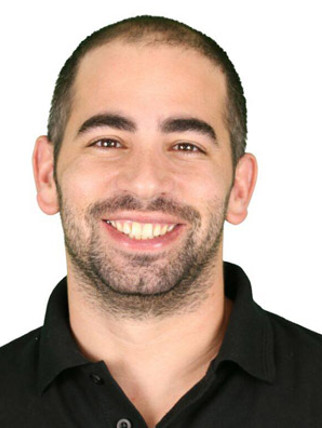Source:
The TURBO convention
Preface
The performance of the Italians in the global bridge concerning bidding is outstanding. Their ability to produce innovative and reliable bidding systems and techniques proved also form the fact that there are at least 6 Italians in the first twelve places in the world ranking the last fifteen years. It is now clear that the era that began 60 years ago with artificial systems continues successfully today with the evolution of the natural systems and the use of relays. However it is remarkable the small number of professional pairs who adopt successful bidding techniques and conventions like the TURBO convention.
One of the fundamentals of the bidding systems developed by the Italians is the TURBO convention. This convention has been used from the 50s, but has evolved considerably since and used, with different variations, by all top pairs; Lauria-Versace, Bocchi-Madala ( Bocchi-Duboin previously). However, the methods used by these pairs, although they have proven extremely effective, they find little impact. Especially the TURBO convention does not adopted as one would expect. Perhaps the reason is the ambiguity that created when first considering the use of the convention.
In this article I will try to show how much this convention is misunderstood and to present as much items as I managed to gather by studying hands played by the above pairs the last decade. As you probably don’t know TURBO has the smallest spread among writers even in books dedicated to convention for slam bidding and therefore there was not any great help from literature. The only significant source of data was the essay “Turbo. Yesterday. Today & Tomorrow” by the Poles Marek Wojcicki & Wlodek Krysztofczyk.
The presentation of the convention as shown below is mainly based on hands that were played in important championships by these pairs. For each hand there is a detailed description and a short reference to each bidding system. There is also an analysis on how to bid the hand using Blackwood related conventions: RKCB, RKBB, Minorwood, Redwood etc).
Introduction
This conventional method was designed to be employed with the Neapolitan cue-bid, which shows a first or second round control (Ace or King or singleton or void) after a suit-fit has been established. The Neapolitan cue-bid is a feature of the Neapolitan System, which was principally developed by Eugenio Chiaradia, but which in later years was further revised by Benito Garozzo in 1965 and which was renamed by him as the Blue Team Club. This conventional method, which is incorporated in the Blue Team Club, then allows the bidder to inform the partner about the number of Aces and/or Key-Cards held (KCs hereafter).
The most common approach to slam bidding is based on cue-bids and asking for aces (or key cards – the four aces and the king in the potential trump suit). Cue-bids are an opportunity for the exchange of information, sometimes intuitive but no doubt precise. Asking for aces is usually the final stage in the bidding. Then the two-way exchange of information ends. One of the partners – who asked for aces – becomes the captain and he decides about the further development. This is more or less world standard – cue bids and Roman Key-Card Blackwood (RKCB).
The fundamental concept of the TURBO convention is that the partner rebids 4NT to show an even number of Aces and/or Key Cards (0/2/4). This may only occur after a cue-bid has been made showing a first or second round control after suit establishment. If the partner rebids higher than 4NT (or bypass 4NT), then this action shows an odd number of Aces and/or Key Cards (1/3/5) and, in most cases, also a control in that named suit. The bid, therefore, of 4NT does not ask for the number of Aces and/or Key Cards, but rather shows a definite number of Aces and/or Key Cards.
The problem is, that only one of the players can count the total number of key cards, so if he knows that there is still a chance of a slam, he must share that information with partner by continuing the cue-bids.
The importance of cue-bidding
The following are taken from the essay “Cue-Bidding to Slam by Claudio Petroncini and Giorgio Belladonna, 1990. Playing bridge you may happen to have something like this hand and dummy:
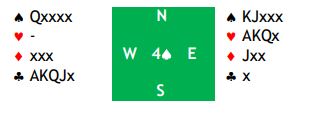
Whoever opener is, your system would be unlikely to allow you to stop at the right level of a 3

partial. Your observation, after having gone down in the contract of 4

(unless the opponents generously ignore the diamond suit), would reasonably be: “There’s no way to stop in a partial with 10 trumps, 26 HCP and a side singleton and void!”.
But, if we leave West’s cards the same, and switch East’s hearts and diamonds, even removing the

Q. we obtain this layout:

No matter whether the opening was by East or West, there aren’t many systems that have the advantage of a slam-investigating treatment sophisticated enough to find the ideal contract of 6

. Your observation, after climbing to the height of 4

, would be in this case, also correct: “With just 24 HCP what were the chances that the Jack third of hearts with East would face West’s void and that the 3 small diamonds in West would be covered by the Ace and King with East, the only set of holdings to make slam cold?”
This example serves to show that point-count can’t be the only consideration; in fact the contract depends on many elements; suit-length, location of honors, and doubletons, singletons, and voids may each contribute to determining the choice of final contract.
No system today lets you examine all the elements on which the contract depends a low level, and still offers the chance, in each case, to stop in a partial or to continue toward the more ambitious objectives of game and slam. Therefore accept that, when you are in the partial/game zone, in which you don’t always have the luxury of lots of bidding room, despite scrupulously adhering to the adopted system (no matter how efficient it is) you may manage to bid an unmakeable game or stay out of a cold one because of the particular layout of the opposing cards; in bridge, in which every problem should be tackled based on probabilities, the unlikely layouts that make the bidding look bad shouldn’t be considered when constructing and evaluating a system.
To the contrary, when you are in the game/slam zone, in which you can make use of lots of bidding space, it’s now possible to adopt a sophisticated treatment that takes into consideration all the above-mentioned elements fundamental to determining the level of the contract. In particular, cue-bids, when there is bidding room, if adequately utilized, offer the ability to carry out an investigation of honor location and any distributional values otherwise difficult if not impossible to communicate, allowing precise determination of the chances offered by the hands, and thus bidding slams only if there is a good chance of success.
So cue-bids assume that game is the least ambitious of objectives; because of this they enter the scene only after both strength and distribution have been identified to some degree, giving rise to a dialogue that can be introduced into any system (natural or conventional) at just the moment when, having made sure of being in the slam zone, the inquiries should be tailored to that end.
Finally, supporting the use of cue-bids is their ability to independently coexist with conventions now deeply-rooted into the game of bridge, like asking for Aces and Kings and Grand Slam Force, leaving to the judgment of a single player, depending on the case, the decision of whether to continue down one road or another or both.
Probabilities and Percentages
Is it correct in bridge to bid a small slam depending on a finesse (50% chance of success)? What about a grand slam? The answer is directly linked not only to the type of game in which you pose the problem (tournament or rubber-bridge), but also, and especially for tournament bridge, the moment in which the opportunity takes place. In the case of making the slam, in fact, not only is the score awarded in the open game different from that awarded in a tournament, but in the latter, the consequences are different depending on whether it is a pairs tournament or teams, even if the contract award is the same.
Based purely on mathematical calculation, taking as a model teams event (which, in the long run, rewards the best technique) and considering the conversion to IMPS based on the score-difference on each hand, it’s approximately right to bid the small slam only when the chance of success is at least 50%, while for bidding the grand this should be greater than 57%.
Controls
An essential requirement for making a slam contract is that there are not only the theoretically necessary tricks, but also the necessary controls in the suits. In a no-trump slam, by a control in a suit is meant a combination of cards that manages to stop the enemy from immediately taking 1 trick, if the control is first-round (Ace), or 2 tricks if the control is second-round (King).
In a suit slam the void becomes equivalent to the Ace (and so is considered a first-round control) and the singleton becomes equivalent to the King (and so is considered a second-round control). Controls may be either immediate (to transfer initiative from the opening leader to declarer on the first trick -grand slam-, or on the second trick-small slam-) or preventative (impeding the opponent from cashing the setting trick on the next round). The method for verifying that the combined strength of the two sides would theoretically support taking 12 or 13 tricks depends on the system played and, in that respect, both traditional and modern systems are effective. The points necessary for bidding slams (if other conditions are sufficient, naturally):
In No-trumps:
with opposing balanced hands with no 5-card suit
SMALL SLAM 33 HCP
GRAND SLAM 37 HCP
with opposite balanced hands with AT LEAST ONE 5-card suit
SMALL SLAM 32 HCP
GRAND SLAM 36 HCP
In A Suit:
with opposite balanced hands with a fit
SMALL SLAM 32 HCP
GRAND SLAM 36 HCP
The method to ascertain the presence of controls depends on the rules imposed by each system the moment slam investigation begins. These rules are different from those for investigating game, and the dialogue has the characteristics of a complete system within a system.
The Dialogue
The “slam dialogue” or more concisely “dialogue” is the formal synthesis of all the rules for the bidding phase where, assuming that it has been established that there is enough strength for game, the investigation should be turned to the pursuit of slam. In this respect systems differ appreciably: in the course of the dialogue, in fact, the bids often have more frequent and complex conventional meanings the more modern the system is. Naturally the effectiveness of the dialogue is directly related to the bidding space available: the more space there is, the more information is transmitted, with the consequence that the lower the level the dialogue begins, the more reliable the final contract. Its this reasoning that inspired some modem systems, which, to that end, have all 2-over-1 new-suit responses force to game.
This affects the slam-bidding dialogue too, a sophisticated mechanism of cue-bids, (or “cue-bidding dialogue”), relatively effective if begun at high levels, but extremely precise if Initiated at a low level. The information transmitted by a cue-bidding dialogue started at a low level is of such wide scope that it almost always renders obsolete the myriad of different conventions created by ardent imaginations of theorists for sorting out controls during this century.
The Cue-bid
To start the dialogue, the bid of any suit (

,

,

,

) besides trumps loses its natural meaning (showing a suit or extra length) to a conventional one, to help find slam, showing a control in the suit, a cue-bid. The cue-bid (literally: suggestive bid) is a conventional bid with which you communicate the possession of control of the suit.
In no-trump contracts, its usually at a high-level that a misfit is finally diagnosed so the resulting limited space available doesn’t lend itself to a cue-bidding dialogue.
In trump contracts, where the cue-bidding dialogue is most efficient, each cue-bid shows Information:
a) directly, with a cheap bid of a suit:
- first-round control (either Ace or void)
- second-round control (either King or singleton)
b) indirectly, skipping the suit at the lowest level
- absence of 1st or 2nd round control.
Possible initial ambiguity between 1st and 2nd round control is subsequently eliminated with the precise rules of the dialogue. To start the dialogue, cue-bids should follow each other according to an ideal plan established by the rank of the suit, where skipping a suit denies control of the suit skipped and control of the bid suit.
The above “logic” of cue-bidding is according to the Italian way”. Others use a different approach where at first we show tu round controls (Aces and voids) and at a later stage we show rd controls (Kings and singletons). Or. In recent past, some used to show sults where there is no 1st or 2nd round controls and bypass (skip) suits with 1st or 2nd round controls.
Suggesting Third-Round Controls
As the dialogue develops through numerous bidding sequences, the rules for the dialogue allow identification, in suits lacking controls, of any supplementary holding, though of less importance, that nevertheless can turn out to be decisive for getting to slam.
In these cases each bid in a suit previously skipped (showing no control) also belongs to the category of cue-bids (in the sense that it sends useful information for slam-bidding), and should be identified so as to immediately render without any ambiguity the type of holding, and shows:
a) Queen,
or b) Doubleton
Not really a cue-bid, but more a cue-bid of a Queen or Doubleton is the proper description of the bids that have the object the suits which have, while not 1st or 2nd round control, still support in the form of a Queen or doubleton, “third-round control”. In complex bidding sequences, if a cue-bid shows first-round control but denies the AK combination, its possible to use a later cue-bid in the suit to reveal a supporting Queen, so AQ or KQ.
The basics of TURBO
The Italian school of slam bidding was always based on cue bids. As I said before, from the times of the old Blue Team they also discarded Blackwood at most bidding positions. To maintain in control of the number of aces, or key cards, the TURBO convention (although the name was changing) was used in their classic systems. It left more space, and allowed more flexibility when exchanging cue bids. The convention was further developed in later years, but the main idea remained as was cited in the Introduction.
The key to Turbo is the operational function of the 4NT bid. When made, usually in a string of cue bids, it shows an even number of key cards. When it is bypassed, including the established trump suit, it shows an odd number of key cards. So:
4NT – 0, 2, or 4 key cards (out of 5 key cards)
5 any 1, 3, or 5 key cards
How to recognize if it is 0, 2, or 4?
This comes from the context of the bidding! There is no clear rule. Players must deduce partner’s intentions and draw conclusions from the previous bids. Extremely important is the information about the strength and good features of partner’s hand!
When the times of the old Blue Team were passed, most of the world forgot about TURBO. But the next generation of the Italian players revived it in a modified form. All great Italian pairs: Lauria-Versace, Bocchi-Madala, previously also Bocchi-Duboin, use Turbo. Each of them in a slightly different way.
Not only that, the scope of Turbo is also very different. Lauria and Versace use a variation of Turbo prepared by Lauria called VTL (Variante Turbo Lauria) at very specific situations. We will explain everything with examples. When someone searches the Internet for the TURBO convention usually finds the following hand which causes no interest in the topic that dealt with. The reason the hand below is presented as TURBO example, is to show that a bad example and false explanations can easily lead to rejection of a very important convention.
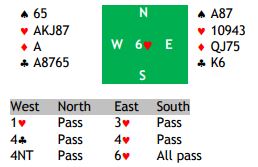
It is commented: “In the above auction, the first response of East of 3

promises a limit raise, generally with a 4-card trump support, and establishes the trump suit. The 4

rebid by West then becomes the Neapolitan Cue-bid showing either a first or second round control in Clubs. When East rebids 4

, this informs West that East does not hold any first or second round control in Diamonds, because East “by-passed” the Diamond suit. West, however, is still interested in a possible slam, and rebids 4NT, which is then the TURBO conventional method, and not any form of the Blackwood convention.
The 4NT bid by West promises an even number of Aces and/or Key Cards: either 0, or 2, or 4 Aces and/or Key Cards. In the above example, East, after first making a limit raise, realizes that West has four Key Cards, and possessing one Ace and/or Key Card, East will then place the contract at: 6

. If East holds no Ace and/or Key Card, then simply signs off at 5

“.
In the above example many mistakes were made and false explanations were given on how to proceed someone to slam investigation using TURBO. Let’s see how the hand should be bid and at the same time to demonstrate some basic features of TURBO.
1. What does East show by 3

? He shows a limit raise with at least a four-card fit and 10-11 HCP. In case East is unbalanced (any singleton) then might have as much as 8 HCP.
2. Should West be interested in slam? Yes he should, because East can have the missing key-card and the

Q or the valuable

KQ or

K and

shortness with five trumps or whatever.
3. It is correct from West point of view to ask directly for key-cards over the 3

bid? No, it is not, because West is looking for specific controls. For this reason he should start cue-bidding.
4. What should be the continuation over 3

? A) In case West holds a control in spades (Ace or void or King or singleton) he should show that by bidding 3

. B) As long as he holds two small cards he should bypass the 3

bid.
5. Bypassing 3

next is the 3NT bid. What 3NT would show? In modem bidding systems this bid is played as Serious or Non-serious about slam prospects. That means that 3NT is not a proposal for another contract (showing perhaps a balanced shape) but shows interesting in slam. A) In case you play 3NT as Serious it shows a strong intention to slam and forces East to cue-bid any control he has. Otherwise, if West makes a cue-bid at the four level he shows a less strong intention to slam and East can sign-off if he’s minimum. B) In case you prefer to play the 3NT bid as Non-serious then the opposite happens, i.e. East can sign-off if he’s minimum over West’s 3NT or start cue-bidding if he’s maximum; and East is forced to cue-bid regardless his strength if West cue-bids (i.e. when West bypass 3NT). In this text we assume that 3NT is always Non-serious.
6. Now we have reached the most critical point of the bidding because West has to evaluate his hand and he must decide what kind of information should be transmitted to his partner. The evaluation depends on several factors such as the point range (shown previously by his partner-East), the overall strength, the shape, the controls and the key-cards of his holding. Avoid classifying the above in order of Importance was done on purpose. If the strength of partner’s hand is unlimited (e.g. 1

-2

-2NT-3

) then we need to show in order of priority: a) the overall strength of our hand. b) our distribution and c) our key-cards. But if the strength of partner’s hand is limited (like in our example) then we must classify our hand in order of priority: a) the keycards, b) the distribution and c) the overall strength.
7) In our example West is holding four KC’s a nice distribution and a non minimum hand (16 HCP) but still a 5 loser hand. East promised a limited hand so it is too much to expect from East to cover 4 losers but still slam it’s possible. Therefoe east should evaluate his hand as Non-Serious. Let’s evaluate some hands:

8) Therefore, West must evaluate his hand as Non-Serious and bid 3NT bypassing 3

since doesn’t have a control in spades.
9. What does East realize from 3NT bid by West? East knows after 3NT that: A) West is interested in slam otherwise he would bid 4

over 3

; B) he doesn’t hold control in spades otherwise he would bid 3

over 3

; C) he holds either a medium-strength hand with a lot of key-cards (at least three) or a strong hand with a few KCs (up to two) otherwise West would have bypassed 3NT and cue something as Serious.
10. After 3NT East’s first priority is to decide whether his holding is worth a cue-bid or is not worth and therefore should sign-off in 4

. In the first case he should examine if he holds a control in spades which is the suit that West has already showed no control (second priority).
11. How does East show control in spades? He shows it by simply not signing-off in 4

; therefore either with 4

/4

/4

/4NT/5

. What do all these bids show? a. 4

shows control in spades but NOT control in clubs. In that case, provided that West also has no control in clubs, he will sign-off in 4

immediately otherwise continues cue-bidding. b. 4

shows control in spades, control in clubs but NOT control in diamonds. In that case, provided that West also has no control in diamonds, West will sign-off in 4

immediately; c. 4

control in spades, control in clubs, control in diamonds and one KC (Odd KCs) d. 4NT shows one control in spades, control in clubs & diamonds and even KCs (two KCs for sure otherwise he shouldn’t evaluate his hand as maximum earlier)
12. East’s hand is neither to weak for a sign-off bid (e.g.

Kxx

Qxxx

Kx

Qxxx) nor to strong (e.g.

Axx

xxxx

Kxxx

Kx). But due to the 3 controls and the key-card he should evaluate the hand as strong having in mind to pull the breaks on next bid. So East’s bid over West’s 3NT is 4

(showing the

K and denying diamond control at the same time).
13. West continues cue-bidding with 4NT (Even KCs) and control in

‘ s having in mind to proceed in slam in case East is holding either one key-card or the

Q as long as East is holding the

K (the most valuable card in the deck).
14. West continues with 4NT showing even key-cards (four KCs for sure). After 4NT East knows that partnership holds all the KCs but he doesn’t know if partner holds the

Q. To show that he bids 5NT sending the message “Partner we have all KCs but I don’t have the

Q. Besides I don’t have any other control except that in spades and clubs”.
In our example the worst error was not to mention the absence of spade control by West and that the 4

would show spade and club control and no diamond control. On the other hand the attempt is correct since the hand has over 50% chance of success for twelve tricks.
To sum up the correct bidding should be:
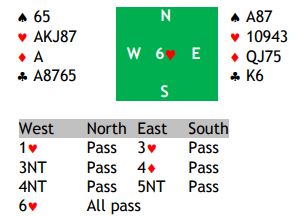
At this point one might wonder: “why should play TURBO and not RKCB? 1.e. after 4

by East, West knows enough and can simply bid Blackwood ending in 6

exchanging the same information?” In this case you are right. There is no benefit by playing TURBO but consider the following simply argument. In case the partnership was playing Serious 3NT then West should bid 4

over 3

to show mid invitation in slam. After 4

East should bid 4

to show control in spades but no control in diamonds. Now there is ambiguity about clubs and West cannot bid Blackwood because he doesn’t know East’s valuable control in clubs.
BUT if TURBO was used then East can continue cue-bidding and bid 5

showing the club control. Below is shown how the bidding had to go in case partnership played Serious3NT;
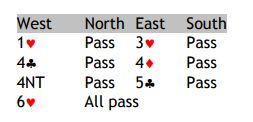
East’s 4

promised spade control and denied diamond control. Since West had diamond control he showed by not bid 4

. West’s 4NT showed diamond control and even KCs . What 4

by East will show? East’s 4

would not a cue-bid since East had already denied spade control, therefore 4

would show something completely irrelevant to spades; 4

would show the trump queen. Therefore, East’s 4NT denied also the

Q. East doesn’t know whether West holds 2 or 4 KCs but that will be clarified in the next round.
Next East bids 5

showing club control and Odd KCs. In case East holds the

Q and no club control he would bid 5

. As we said previously 5

cannot show control since East has already denied diamond control. 5

would show the trump queen. 5

over 4NT would show no club control and no

Q. In case West hold Just 2 KCs he would bid 5

over any bid by West. Now If West holds 2 KCs he would bid 6

.
Do all previous presentation and remarks are somewhat complicated? Certainly they are, besides nobody said that TURBO is an easy convention.
Before continuing with the rest of TURBO, we will see some amazing techniques by using TURBO in defensive and competitive bidding. From this point we should keep some basics like:
1. To activate the TURBO convention one of the partnership should start cue-bidding and the other cooperate continuing cue-bidding up to 4NT.
2. TURBO is the process where the 4NT bid shows an even number of key-cards (0/2/4) and bypassing the 4NT bid, bidding anything at 5-level, shows an odd number of KCs (1 /3/5). Remember that we do not show key-cards at the third or the forth level but only controls. Only 4NT or when bypass 4NT we show number of KCs.
3. TURBO is used when a fit is established previously and therefore there are five key-cards, the four Aces and the King of trumps.
4. TURBO works with Italian cue-bids which means that controls in suits are shown up the line, which means that if a suit is bypassed denotes absent of control in that suit. Controls consider either the Ace (Ax+) or the King (Kx+) or a void or a singleton.
5. When any of the partnership discover the absence of a control in a suit he must transfer that information by signing-off to the cheapest game-level. In case one holds a control in a suit that already bypassed by his partner (i.e. showing no control in that suit) he must also show that by not signing-off. He should bid a suit that he doesn’t have a control (up-the-line) and bypass suit or suits with control.
6. The ambiguity that created playing TURBO about the exact number of key-cards (0/2/4 or 1 /3/5) is the most serious reason the convention is not accepted by many. Extremely important is the information about the strength and good features of partner’s hand. The partnership who plays TURBO must have a robust, disciplined and well-documented system where the exact strength comes from the context of the bidding. There is no clear rule. Players must deduce partner’s intentions and draw conclusions from the previous bids. In the following examples used the bidding systems of Bocchi-Madala, Lauria-Versace, etc. All systems provide the ability for the description of the shape and the range of strength of the hands and the establishment of the trump suit before the four level where the cues begin.
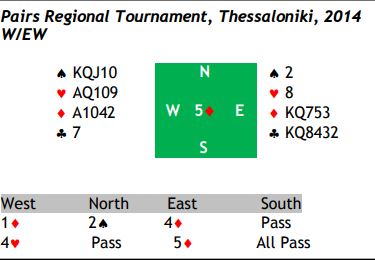
This hand demonstrates the usefulness of TURBO in competition. West can easily check for key-cards and a possible

void in East’s hand. Firstly started by showing that he holds even KCs (4

). East now knows that two KCs are missing (in case West has just two) and signs-off (5

). In case East had hold 2 KCs he would have cue with 4

. In case West had hold 4 KCs he could have continued cue-bidding or bid the slam. Of course in case West had hold 4 KCs he would have reached 6

.
The Trump Queen
Checking for the trump queen is like checking for controls and key-cards by cue-bidding smoothly up the line. The first who bid at the five level shows if he is holding or not the trump queen. The key-bids are 5

and 5NT. Both 5

and 5NT bids deny, at first, the trump queen and at the same time 5NT send the message that the partnership hold all key-cards (the 4 Aces plus the trump king) and no other king. In opposite 5

may be just a cue if earlier no one promised control in clubs or when clubs is one’s second longest suit. On the other hand any other bid at the five level is a cue showing also odd key-cards and the trump queen. Finally, bidding directly the trump suit at the five level shows odd key-cards and the trump queen but denies any other control.
Thus, the impression that the check of the trump queen is made above the 5 level of the established suit is completely wrong. At least in the modern versions of TURBO. On the other hand the way of finding the trump queen is different compared to the RKCB method and also is more complicated. The most important thing to be noted is that, as in the cue-bid process, we do not ask for the queen (like in RKCB) but instead say if we have it or not during cue-bidding. There are several ways in which we declare the possession or not of the trump queen. Let’s see some examples.
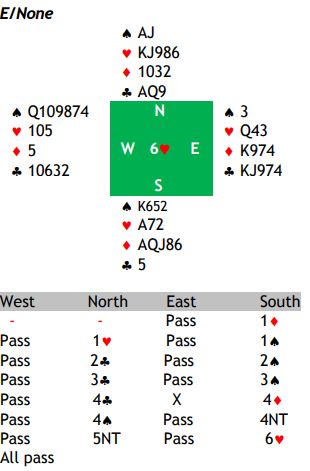
The system used here is that of Lauria-Versace. A new element involved here is the procedure to be followed when we get doubled during cue-bidding.
Bidding:
1

– could be up to 19 HCP unbalanced but with at least 5 losers.
2

– check-back; Invite or better,
2

– 3-card fit in hearts; unbalanced (min or max, but up to 15 hcp),
2

would show less than 3-cards in hearts / 2

would show a 3-card fit in hearts balanced 12-14 HCP / 2NT would show 4225 15-19 HCP /3

would show 4054 with extras/ 3

would show 4

and 6+

with extras
3

– sets hearts as trumps, slam invitational or better, relay,
3

– 4351 shape, maximum or good hand,
3

would show a 4360 shape maximum/3

a 4360 minimum/3NT would show 4351 min,
4

– cue and, because South is known to have shortness there he implies the

A or

void
4

cue. At this point we have an opportunity to show how to continue when opponents double a cue-bid. First we must consider that double shows values (ace or king) and not only length. As already mentioned cue-bids promise first or second round controls (i.e. either Ace or void or King at least doubleton or any singleton). Therefore double is dangerous only when a) the one who makes the cue-bid is exposed to the opening lead (the lead is going to take his partner) and b) he holds a King at least doubleton. How his partner reacts over double? Well, pass would show at least a weak doubleton, re-double would show either an ace or void and by continuing cue-bidding would show either the king or the queen or a singleton. After pass (at least a weak doubleton) the one who makes the cue that was doubled can either: a) re-double to show a first round control, or b)contlnue cue-bidding to show a singleton or KQ, or c) bid the trump suit at the cheapest level to show a king at least doubleton (normally to play it).
4NT – TURBO, i.e. even key-cards and in this case two KCs for sure because he wouldn’t show a maximum hand previously (3

) without any key-card.
5NT – Informs partner that not missing any key-card but missing the trump queen.
6

– a reasonable contract with chances of success over 50%.
The following example shows the use of TURBO at the 5-level in conjuction with the trump queen.

The bidding system which has been used in the above example has nothing to do with the Bocchi-Madala bidding sequence actually used.
Bidding: 3

= both minors 5+4+ or 6+minor slam invitational
4

= 4/5

, no 4

(3NT without a 4+ minor)
4

= even KCs (two KCs for sure from Madala’s point of view)
4

= asks for the

Q
5

= I have it plus control in spades (without the

Q but with 6 cards in

s he would have bid 4NT) and of course without the

Q and with 5

he would have bid in 5

.
7

= Wow! Madala easily counts 13 tricks (14 actually) holding the valuable doubleton

KQ (

Kx would be also enough).
In the above example is showed the way we use the 4

bid (the very next suit) to find the trump queen. Also it is pretty clear that logic plays a significant role in the cue-bidding process. Playing TURBO every hand is an adventure; there are not easy hands. Suppose some small changes in the above example:

The bidding would be the same up to 5

. But 5

would denied the

K (as it was explained earlier) and therefore SOUTH would bid just the small slam. When one shows a two-suited hand, the worst holding in a suit for his partner is three small cards.
Finally suppose, in the above example, that NORTH holds:


. How would be possible for SOUTH to find the

Q and bid the grand? Well, as we said previously, we should involve logic! SOUTH after 5

should bid 6

. What 6

could be? SOUTH knows that NORTH does not have the

K( therefore the 6

shows

Kxx and asks for the

Q.
The Trump Queen when clubs is trumps, Kick Back Turbo & Turbo a la Lauria
You may have noticed that so far did not given example with clubs as trumps. This was done deliberately because it is not possible to use the 5

bid as an in-between bid to show or not to show the

Q. The solution is to use the 4

bid as TURBO and the 4NT bid to show the

Q. Therefore, by not bidding 4NT, during cue-bidding, we deny the

Q. This method called “Kickback TURBO” and is similar to “Kickback Blackwood” when we ask for keycards with 4

(instead of 4NT) when hearts is trumps.
An obvious question would be: “Why not use the same principle when diamonds or even hearts is trumps?” That means that we could use the 4

as TURBO when diamonds is trumps suit and 4

when hearts is trumps. The answer has been given previously concerning the technique we use when a cue-bid is doubled. When the 4

bid is used for TURBO, (and thus not promising a control in diamonds), then in case 4

is doubled, is not possible to evaluate the diamond suit without doubt. Remember when 4

is doubled then: re-double shows

A or

void, pass shows at least a weak doubleton and continuing bidding shows either singleton or the

K or

Q at least doubletons. But in case 4

not promising the

K then we cannot take advantage of the

Q and the control in diamonds is ambiguous.
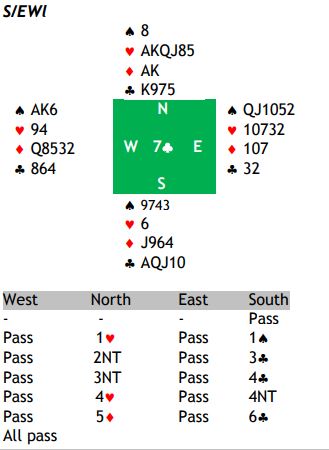 The GAZZILLI convention is implemented here.
The GAZZILLI convention is implemented here.
Bidding:
2NT = 6

and 4m, 15+ hcp,
3

= relay,
Other bids:
3

= 4

6

, 3-7 HCP
3

= 3

, balanced, 4-6 HCP
3

= weak 6-card suit without 2

and without a 4-card minor,
3NT = 6

4

, 18+ HCP (other bids: 3

=6

4

15-17/3

=6

4

15-17/3

=6

4

18+ hcp).
4

= sets a as trumps.
4

=

cue with Odd key-cards i.e. either 3 or 5; 4

would show even key-cards.
4NT = shows the

Q no

control and at least one key-card (without any KC would bid 5

).
5

= promises at least 3 key-cards and control in spades.
The key bid here is the 4NT which promises three things: 1) the

Q according to our agreement when clubs is trumps, 2) no control in spades since SOUTH by-passed the spade cue-bid, and 3) at least one key-card since NORTH could easily has only 3.
One could wonder about the control in diamonds in the above agreement? Who controls diamonds and how can we show that. Well there is a hole indeed. Some play the 4NT as a diamond cue-bid but lose this bid to show the queen of clubs. There is a way to maximize the chances to have control in diamonds. It’s called VTL (Variant Turbo Lauria) from his inventor the world champion Lorenzo Lauria.
The VTL (Variant Turbo Lauria) is used only when clubs is trumps. The 4

trigger the VTL and shows odd key-cards. By by-passing 4

it shows even keycards and 4NT shows always the

Q. Let’s see how it works:
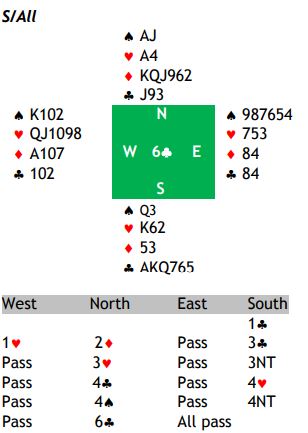
In the above example the 4

bid shows control in hearts and even key-cards (VTL). Later 4NT shows the

Q. Try to bid the hand using RKCB or Minorwood or Redwood. SOUTH 3NT did not promise the

K (might had

Qxx) and thus NORTH has a doubt about the heart suit.
Another solution, is implemented when the club suit established at an earlier stage (e.g. at 3 level). According to this method the first who bid 4

(during cue-bidding up-the-line) denies the

Q, whereas when 4

is by-passed promises the

Q. Of course 4

replaces TURBO and 4NT shows control in diamonds.
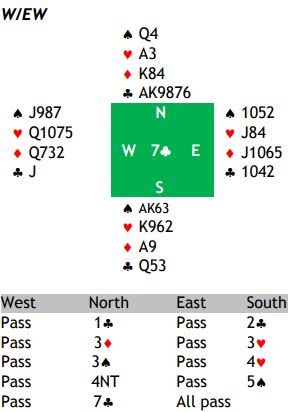
Bidding:
2

Game forcing plus, either a) unbalanced with clubs the longest suit, or b) any balanced at least with 2

3

any 6

(322), 15+ HCP
3

relay, promises 15+ HCP or 13+ HCP with at least 6 controls,
3

15-17 HCP,
4

sets clubs as trumps,

cue, even key-cards, promises

Q
In case SOUTH had not held the

Q he would have bid 4

In case SOUTH had held the

Q and odd key-cards he would have bid 4

(TURBO)
4NT = control in diamonds, denies control in spades, promises 3 key-cards otherwise he would bid 6

5

shows the

AK because: Since SOUTH shows 2 key-cards the

A and the

A are already known to NORTH. Also the

K is known from the

cue-bid. Thus 5

promises something extra: the

K. It should be noted that in case SOUTH did not hold the

K he should bid 6

over 4NT
7

NORTH can count: 3 tricks in spades, 2 tricks in diamonds, 6 tricks in clubs and 2 tricks in hearts, total 13 tricks. The reason not to bid 7NT is that 4

from SOUTH could be just singleton. In the above sequence SOUTH has never promised a balanced hand.
Big Bang method
Are you ready now to venture out into deeper waters? Well, let’s see how Big Bang handling the matter.
Basically, Big Bang uses two methods to check for key-cards and controls dependent on whether the fit is in minors or in majors. Usually, in both cases, the Big Bang bidding system has considered the strength range (minimum [11-14 HCP], medium [15-17 HCP] or maximum [18+ HCP]) and the shape while establishing the trump suit. Due to this, when we are in the slam investigation zone (cues and key-card asking) we know enough, at least for one hand, in order to proceed accurately to the final contract. Of course there are several “special” bids at 4th level which act as Last-Train bids’ in case the exact strength and trump quality are unknown. The most important thing is that 4NT does not show even keycards but used as q-bid in all cases except when spades are trumps and in that case 4NT is used as RKCB.
1. Fit in major:
4NT is never TURBO but RKCB when spades is trumps.
When hearts is trumps then 4

is RKBB (see below) and 4NT show

control (A or K or shortness).
When q-bidding starts the first who identify controls in all suits can ask the number of keycards and the trump queen depending the trump suit (4

or 4NT).
2. Fit in minor:
In most cases fit in minor is established at 4th level (in cases where the fit is established at 3-level, repeating the trump suit at 4-level show different things depending developments previously). The very next bid (4

when clubs agreed as trumps and 4

when diamonds agreed as trumps) show even keycards (2 or 4, with zero keycards we jump to game immediately). Other bids show odd keycards and controls (A or K or shortness). After that we can either: a)continue q-bidding, or b)ask for the trump queen, or c)show intention for small or grand slam.
When one shows even keycards (4

or 4

depending the trump suit clubs or diamonds respectively) then later 4NT bid up the line shows control in that suit (

or

).
As you will discover in the next few examples or when you watch LAVAZZA team in action, Big Bang uses lot of bids to check for controls, number of keycards with or without voids, the trump queen and minimum or maximum hands. The system is accurate but very complex and not easy to play it effectively without practice and hard work.
“Last Train” convention was invented by Jeff Meckstroth and named also by him from the Monkees song “Last Train to Clarksville”. Initially the convention was used to show mild slam values and triggered by bidding the suit just below the game level (i.e. 4

when

is the trump suit and 4

when

is trumps). Nowadays the convention used to show also minimum values, acting as a break, just before any slam attempt.
RKBB or Roman Kick-Back Blackwood is identical to RKCB (Roman KeyCard Blackwood) when spades is trumps. Most players has realized that using 4NT as RKCB when hearts is trumps there is a problem to find the trump queen when answerer uses the second step (i.e. 4

). The next bid is 5

, and is not possible to know if that is a sign-off because a keycard is missing or an asking bid to find the

Q. The solution is to use 4

as keycard asking bid and use the same number of steps and meanings similar to RKCB. At first it sounds easy to play it but you must discuss it and practice with your partner.
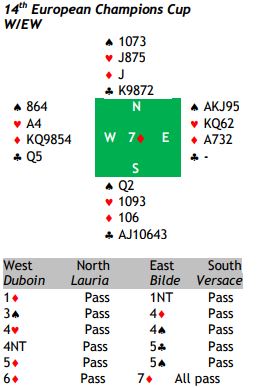
Biding according to Big Bang system:
1

5+

UNBAL or 1444 or 4441, 11+ HCP
1NT either balanced or 5+

UNBAL or 5+

UNBAL, GF+
3

6

(322) either 11-14 HCP or 18+ HCP
4

sets

as trumps, asks cues and keycards
4

Even keycards i.e. 2 or 4 (with 0 he would have signed-off at 5

)
4

cue and promises at least 2 keycards. With one keycard he would have signed-off at 5

4NT

cue, the suit which substitute previously to show even keycards
5


cue
5

not forcing, nothing else to show and minimum (is the first time West showed the 11-14 range)
5

shows interest for grand slam promising the

Q and forces West to continue q-bids
6

declines invitation for 7 with super minimum and uncertain values in clubs
7

I think I make it despite your super minimum
Notes:
- This is an amazing hand where the bidding system provides the necessary tools to allow critical information to be transmitted between EW in order to reach this marginal grand.
- After 3
 East knew that: a) West had no shortness and b) he didn’t need to look for the
East knew that: a) West had no shortness and b) he didn’t need to look for the  Q (10-card fit)
Q (10-card fit)
- After 4
 East knew that West had 2 keycards. If these keycards were
East knew that West had 2 keycards. If these keycards were  A and
A and  K grand would be easy. So he continued q-bidding to collect more information.
K grand would be easy. So he continued q-bidding to collect more information.
- 4NT showed control in
 s and for sure the
s and for sure the  A because: a)West showed no shortness with 3
A because: a)West showed no shortness with 3 and b) East held the
and b) East held the  K.
K.
- In order to found the other keycard East q-bid 5
 (as grand slam attempt) in order to force West to q-bid the
(as grand slam attempt) in order to force West to q-bid the  A. In case West had bid 6
A. In case West had bid 6 then East would have signed-off in 6
then East would have signed-off in 6 . Since West denied the
. Since West denied the  A then held for sure the
A then held for sure the  K (the second keycard he promised with 4
K (the second keycard he promised with 4 ).
).
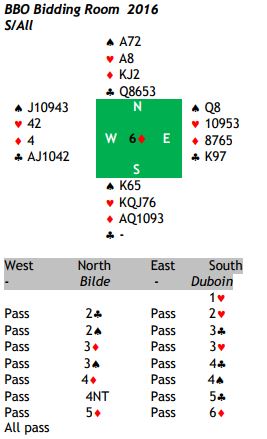
Bidding according to Big Bang system:
2

a GF+, either balanced or unbalanced with

fit or unbalanced with long

s or any (4441)
2

either 5+

4+

or 5

(332) without weak doubleton in

s or in

s, 11-14 HCP
2

a relay asking shape
3

at least 10 cards in

and

(either 5+5 or 6+4)
3

relay asking shape
3

5+

5

3

relay asking strength
4

15-17 HCP
4

sets

as trumps
4

Odd keycards and cue in

4NT shows

cue (the suit which used to show even keycards)
5

cue
5

no

Q
6

I have it
Recapitulation
The following shortcuts based on what we discussed in the previous chapters and according to preferences most top pairs play today.
1. TURBO convention used instead of Blackwood (or similar methods like RKCB, RKBB, Redwood etc)) to identify the number of key-cards. Blackwood (4NT) used, unless otherwise specified, when someone jumps to 4141 from the 3-level when the trump suit established, without make any cue-bid at the 4 level (3NT normally shows max or min hands and considered as the beginning of cue-bids).
2. TURBO convention is applied during cue-bidding (dialogue) after a suit established as trumps at the th level or earlier. TURBO related with cue-bidding according to the Italian methods, i.e. controls in suits (Ace or void, or Kx• or singleton) are showed up the line. When someone reaches and bit 4NT shows even key-cards (0/2/4) otherwise when 4NT is by-passed he shows odd key-cards (1/3/5).
3. To activate the TURBO convention one of the partnership (‘Player A’ & ‘Player B’) should start cue-bidding and the other cooperate continuing cue-bidding up to 4NT. When someone jumps in 4NT without any cue-bidding at 4th level TURBO is off and Blackwood (RKCB) is applied.
4. During dialogue when ‘Player A’ by-pass a suit (e.g. ‘Suit 1’) he denies control in this suit (at least a doubleton without an Ace or a King). After that, if ‘Player B’ continues cue-bidding (e.g. ‘Suit 2’) he shows control in ‘Suit 1’ but denies control in ‘Suit 2’. Example: Assume spades established at 3-level and cue-bidding goes: …3

– 4

-4

.4

promises control in diamonds and denies control in clubs; 4

promises control in clubs and denies control in hearts.
5. If someone discovers lack of control in a suit he must inform his partner immediately in order to stop further slam investigation. Example: In the above example if ‘Player B’ had not had control in clubs too he would have signed-off (4

) immediately.
6. When the establishment trump suit is a major the trump queen is denied, during dialogue, when one bids 5

up-the-line. Similarly the trump queen is shown by bidding something else than 5

at the five level. Specially the direct 5NT over 4NT shows all key-cards but not the trump queen. CAUTION:5NT is not Joshephine when cue-bidding is in progress.
7. The same principle applies when diamonds is trumps but consider also point #8 below.
8. When clubs is trumps then 4

replace TURBO and 4NT shows the

Q. The used method is the VTL method where 4

shows odd key-cards (Turbo a la Lauria). This principle does not apply when diamonds or hearts is trumps.
9. When a minor suit established at 3 level or earlier, there is an additional method the trump queen to be shown. The first who bid the trump suit at the 4 level denies the trump queen, otherwise he shows it. Example: Assume diamonds established at 3 level and the bidding goes: …-3

-4

-4

. 3

and 4

are cue-bids, 4

is not for sign-off but shows lack of the

Q. Similarly 4

after 4

would show a heart cue and the

Q as long as 4

was by-passed.
10. 5

could show either a control or lack of the trump queen. When shows control in clubs it’s possible to hold the queen of rumps as well. Therefore, the case should be clarified. 5

asks for clarification in case the one who bid 5

hold either the trump queen or control in diamonds. Without any of them he should bid the trump suit. The one who has bid 5

always bids the trumps suit without the trump queen or continues cue-bidding with the trump queen and club control.
 Whoever opener is, your system would be unlikely to allow you to stop at the right level of a 3
Whoever opener is, your system would be unlikely to allow you to stop at the right level of a 3 No matter whether the opening was by East or West, there aren’t many systems that have the advantage of a slam-investigating treatment sophisticated enough to find the ideal contract of 6
No matter whether the opening was by East or West, there aren’t many systems that have the advantage of a slam-investigating treatment sophisticated enough to find the ideal contract of 6 It is commented: “In the above auction, the first response of East of 3
It is commented: “In the above auction, the first response of East of 3 ? He shows a limit raise with at least a four-card fit and 10-11 HCP. In case East is unbalanced (any singleton) then might have as much as 8 HCP.
2. Should West be interested in slam? Yes he should, because East can have the missing key-card and the
? He shows a limit raise with at least a four-card fit and 10-11 HCP. In case East is unbalanced (any singleton) then might have as much as 8 HCP.
2. Should West be interested in slam? Yes he should, because East can have the missing key-card and the  Q or the valuable
Q or the valuable  KQ or
KQ or  K and
K and  shortness with five trumps or whatever.
3. It is correct from West point of view to ask directly for key-cards over the 3
shortness with five trumps or whatever.
3. It is correct from West point of view to ask directly for key-cards over the 3 bid? No, it is not, because West is looking for specific controls. For this reason he should start cue-bidding.
4. What should be the continuation over 3
bid? No, it is not, because West is looking for specific controls. For this reason he should start cue-bidding.
4. What should be the continuation over 3 ? A) In case West holds a control in spades (Ace or void or King or singleton) he should show that by bidding 3
? A) In case West holds a control in spades (Ace or void or King or singleton) he should show that by bidding 3 . B) As long as he holds two small cards he should bypass the 3
. B) As long as he holds two small cards he should bypass the 3 bid.
5. Bypassing 3
bid.
5. Bypassing 3 next is the 3NT bid. What 3NT would show? In modem bidding systems this bid is played as Serious or Non-serious about slam prospects. That means that 3NT is not a proposal for another contract (showing perhaps a balanced shape) but shows interesting in slam. A) In case you play 3NT as Serious it shows a strong intention to slam and forces East to cue-bid any control he has. Otherwise, if West makes a cue-bid at the four level he shows a less strong intention to slam and East can sign-off if he’s minimum. B) In case you prefer to play the 3NT bid as Non-serious then the opposite happens, i.e. East can sign-off if he’s minimum over West’s 3NT or start cue-bidding if he’s maximum; and East is forced to cue-bid regardless his strength if West cue-bids (i.e. when West bypass 3NT). In this text we assume that 3NT is always Non-serious.
6. Now we have reached the most critical point of the bidding because West has to evaluate his hand and he must decide what kind of information should be transmitted to his partner. The evaluation depends on several factors such as the point range (shown previously by his partner-East), the overall strength, the shape, the controls and the key-cards of his holding. Avoid classifying the above in order of Importance was done on purpose. If the strength of partner’s hand is unlimited (e.g. 1
next is the 3NT bid. What 3NT would show? In modem bidding systems this bid is played as Serious or Non-serious about slam prospects. That means that 3NT is not a proposal for another contract (showing perhaps a balanced shape) but shows interesting in slam. A) In case you play 3NT as Serious it shows a strong intention to slam and forces East to cue-bid any control he has. Otherwise, if West makes a cue-bid at the four level he shows a less strong intention to slam and East can sign-off if he’s minimum. B) In case you prefer to play the 3NT bid as Non-serious then the opposite happens, i.e. East can sign-off if he’s minimum over West’s 3NT or start cue-bidding if he’s maximum; and East is forced to cue-bid regardless his strength if West cue-bids (i.e. when West bypass 3NT). In this text we assume that 3NT is always Non-serious.
6. Now we have reached the most critical point of the bidding because West has to evaluate his hand and he must decide what kind of information should be transmitted to his partner. The evaluation depends on several factors such as the point range (shown previously by his partner-East), the overall strength, the shape, the controls and the key-cards of his holding. Avoid classifying the above in order of Importance was done on purpose. If the strength of partner’s hand is unlimited (e.g. 1 -2
-2 -2NT-3
-2NT-3 ) then we need to show in order of priority: a) the overall strength of our hand. b) our distribution and c) our key-cards. But if the strength of partner’s hand is limited (like in our example) then we must classify our hand in order of priority: a) the keycards, b) the distribution and c) the overall strength.
7) In our example West is holding four KC’s a nice distribution and a non minimum hand (16 HCP) but still a 5 loser hand. East promised a limited hand so it is too much to expect from East to cover 4 losers but still slam it’s possible. Therefoe east should evaluate his hand as Non-Serious. Let’s evaluate some hands:
) then we need to show in order of priority: a) the overall strength of our hand. b) our distribution and c) our key-cards. But if the strength of partner’s hand is limited (like in our example) then we must classify our hand in order of priority: a) the keycards, b) the distribution and c) the overall strength.
7) In our example West is holding four KC’s a nice distribution and a non minimum hand (16 HCP) but still a 5 loser hand. East promised a limited hand so it is too much to expect from East to cover 4 losers but still slam it’s possible. Therefoe east should evaluate his hand as Non-Serious. Let’s evaluate some hands:
 8) Therefore, West must evaluate his hand as Non-Serious and bid 3NT bypassing 3
8) Therefore, West must evaluate his hand as Non-Serious and bid 3NT bypassing 3 since doesn’t have a control in spades.
9. What does East realize from 3NT bid by West? East knows after 3NT that: A) West is interested in slam otherwise he would bid 4
since doesn’t have a control in spades.
9. What does East realize from 3NT bid by West? East knows after 3NT that: A) West is interested in slam otherwise he would bid 4 over 3
over 3 ; B) he doesn’t hold control in spades otherwise he would bid 3
; B) he doesn’t hold control in spades otherwise he would bid 3 over 3
over 3 ; C) he holds either a medium-strength hand with a lot of key-cards (at least three) or a strong hand with a few KCs (up to two) otherwise West would have bypassed 3NT and cue something as Serious.
10. After 3NT East’s first priority is to decide whether his holding is worth a cue-bid or is not worth and therefore should sign-off in 4
; C) he holds either a medium-strength hand with a lot of key-cards (at least three) or a strong hand with a few KCs (up to two) otherwise West would have bypassed 3NT and cue something as Serious.
10. After 3NT East’s first priority is to decide whether his holding is worth a cue-bid or is not worth and therefore should sign-off in 4 . In the first case he should examine if he holds a control in spades which is the suit that West has already showed no control (second priority).
11. How does East show control in spades? He shows it by simply not signing-off in 4
. In the first case he should examine if he holds a control in spades which is the suit that West has already showed no control (second priority).
11. How does East show control in spades? He shows it by simply not signing-off in 4 ; therefore either with 4
; therefore either with 4 /4
/4 /4
/4 /4NT/5
/4NT/5 . What do all these bids show? a. 4
. What do all these bids show? a. 4 shows control in spades but NOT control in clubs. In that case, provided that West also has no control in clubs, he will sign-off in 4
shows control in spades but NOT control in clubs. In that case, provided that West also has no control in clubs, he will sign-off in 4 immediately otherwise continues cue-bidding. b. 4
immediately otherwise continues cue-bidding. b. 4 shows control in spades, control in clubs but NOT control in diamonds. In that case, provided that West also has no control in diamonds, West will sign-off in 4
shows control in spades, control in clubs but NOT control in diamonds. In that case, provided that West also has no control in diamonds, West will sign-off in 4 immediately; c. 4
immediately; c. 4 control in spades, control in clubs, control in diamonds and one KC (Odd KCs) d. 4NT shows one control in spades, control in clubs & diamonds and even KCs (two KCs for sure otherwise he shouldn’t evaluate his hand as maximum earlier)
12. East’s hand is neither to weak for a sign-off bid (e.g.
control in spades, control in clubs, control in diamonds and one KC (Odd KCs) d. 4NT shows one control in spades, control in clubs & diamonds and even KCs (two KCs for sure otherwise he shouldn’t evaluate his hand as maximum earlier)
12. East’s hand is neither to weak for a sign-off bid (e.g.  Kxx
Kxx  Qxxx
Qxxx  Kx
Kx  Qxxx) nor to strong (e.g.
Qxxx) nor to strong (e.g.  Axx
Axx  xxxx
xxxx  Kxxx
Kxxx  Kx). But due to the 3 controls and the key-card he should evaluate the hand as strong having in mind to pull the breaks on next bid. So East’s bid over West’s 3NT is 4
Kx). But due to the 3 controls and the key-card he should evaluate the hand as strong having in mind to pull the breaks on next bid. So East’s bid over West’s 3NT is 4 (showing the
(showing the K and denying diamond control at the same time).
13. West continues cue-bidding with 4NT (Even KCs) and control in
K and denying diamond control at the same time).
13. West continues cue-bidding with 4NT (Even KCs) and control in ‘ s having in mind to proceed in slam in case East is holding either one key-card or the
‘ s having in mind to proceed in slam in case East is holding either one key-card or the  Q as long as East is holding the
Q as long as East is holding the  K (the most valuable card in the deck).
14. West continues with 4NT showing even key-cards (four KCs for sure). After 4NT East knows that partnership holds all the KCs but he doesn’t know if partner holds the
K (the most valuable card in the deck).
14. West continues with 4NT showing even key-cards (four KCs for sure). After 4NT East knows that partnership holds all the KCs but he doesn’t know if partner holds the  Q. To show that he bids 5NT sending the message “Partner we have all KCs but I don’t have the
Q. To show that he bids 5NT sending the message “Partner we have all KCs but I don’t have the  Q. Besides I don’t have any other control except that in spades and clubs”.
In our example the worst error was not to mention the absence of spade control by West and that the 4
Q. Besides I don’t have any other control except that in spades and clubs”.
In our example the worst error was not to mention the absence of spade control by West and that the 4 would show spade and club control and no diamond control. On the other hand the attempt is correct since the hand has over 50% chance of success for twelve tricks.
To sum up the correct bidding should be:
would show spade and club control and no diamond control. On the other hand the attempt is correct since the hand has over 50% chance of success for twelve tricks.
To sum up the correct bidding should be:
 At this point one might wonder: “why should play TURBO and not RKCB? 1.e. after 4
At this point one might wonder: “why should play TURBO and not RKCB? 1.e. after 4 by East, West knows enough and can simply bid Blackwood ending in 6
by East, West knows enough and can simply bid Blackwood ending in 6 exchanging the same information?” In this case you are right. There is no benefit by playing TURBO but consider the following simply argument. In case the partnership was playing Serious 3NT then West should bid 4
exchanging the same information?” In this case you are right. There is no benefit by playing TURBO but consider the following simply argument. In case the partnership was playing Serious 3NT then West should bid 4 over 3
over 3 to show mid invitation in slam. After 4
to show mid invitation in slam. After 4 East should bid 4
East should bid 4 to show control in spades but no control in diamonds. Now there is ambiguity about clubs and West cannot bid Blackwood because he doesn’t know East’s valuable control in clubs.
BUT if TURBO was used then East can continue cue-bidding and bid 5
to show control in spades but no control in diamonds. Now there is ambiguity about clubs and West cannot bid Blackwood because he doesn’t know East’s valuable control in clubs.
BUT if TURBO was used then East can continue cue-bidding and bid 5 showing the club control. Below is shown how the bidding had to go in case partnership played Serious3NT;
showing the club control. Below is shown how the bidding had to go in case partnership played Serious3NT;
 East’s 4
East’s 4 promised spade control and denied diamond control. Since West had diamond control he showed by not bid 4
promised spade control and denied diamond control. Since West had diamond control he showed by not bid 4 . West’s 4NT showed diamond control and even KCs . What 4
. West’s 4NT showed diamond control and even KCs . What 4 by East will show? East’s 4
by East will show? East’s 4 would not a cue-bid since East had already denied spade control, therefore 4
would not a cue-bid since East had already denied spade control, therefore 4 would show something completely irrelevant to spades; 4
would show something completely irrelevant to spades; 4 would show the trump queen. Therefore, East’s 4NT denied also the
would show the trump queen. Therefore, East’s 4NT denied also the Q. East doesn’t know whether West holds 2 or 4 KCs but that will be clarified in the next round.
Next East bids 5
Q. East doesn’t know whether West holds 2 or 4 KCs but that will be clarified in the next round.
Next East bids 5 showing club control and Odd KCs. In case East holds the
showing club control and Odd KCs. In case East holds the  Q and no club control he would bid 5
Q and no club control he would bid 5 . As we said previously 5
. As we said previously 5 cannot show control since East has already denied diamond control. 5
cannot show control since East has already denied diamond control. 5 would show the trump queen. 5
would show the trump queen. 5 over 4NT would show no club control and no
over 4NT would show no club control and no  Q. In case West hold Just 2 KCs he would bid 5
Q. In case West hold Just 2 KCs he would bid 5 over any bid by West. Now If West holds 2 KCs he would bid 6
over any bid by West. Now If West holds 2 KCs he would bid 6 .
Do all previous presentation and remarks are somewhat complicated? Certainly they are, besides nobody said that TURBO is an easy convention.
Before continuing with the rest of TURBO, we will see some amazing techniques by using TURBO in defensive and competitive bidding. From this point we should keep some basics like:
1. To activate the TURBO convention one of the partnership should start cue-bidding and the other cooperate continuing cue-bidding up to 4NT.
2. TURBO is the process where the 4NT bid shows an even number of key-cards (0/2/4) and bypassing the 4NT bid, bidding anything at 5-level, shows an odd number of KCs (1 /3/5). Remember that we do not show key-cards at the third or the forth level but only controls. Only 4NT or when bypass 4NT we show number of KCs.
3. TURBO is used when a fit is established previously and therefore there are five key-cards, the four Aces and the King of trumps.
4. TURBO works with Italian cue-bids which means that controls in suits are shown up the line, which means that if a suit is bypassed denotes absent of control in that suit. Controls consider either the Ace (Ax+) or the King (Kx+) or a void or a singleton.
5. When any of the partnership discover the absence of a control in a suit he must transfer that information by signing-off to the cheapest game-level. In case one holds a control in a suit that already bypassed by his partner (i.e. showing no control in that suit) he must also show that by not signing-off. He should bid a suit that he doesn’t have a control (up-the-line) and bypass suit or suits with control.
6. The ambiguity that created playing TURBO about the exact number of key-cards (0/2/4 or 1 /3/5) is the most serious reason the convention is not accepted by many. Extremely important is the information about the strength and good features of partner’s hand. The partnership who plays TURBO must have a robust, disciplined and well-documented system where the exact strength comes from the context of the bidding. There is no clear rule. Players must deduce partner’s intentions and draw conclusions from the previous bids. In the following examples used the bidding systems of Bocchi-Madala, Lauria-Versace, etc. All systems provide the ability for the description of the shape and the range of strength of the hands and the establishment of the trump suit before the four level where the cues begin.
.
Do all previous presentation and remarks are somewhat complicated? Certainly they are, besides nobody said that TURBO is an easy convention.
Before continuing with the rest of TURBO, we will see some amazing techniques by using TURBO in defensive and competitive bidding. From this point we should keep some basics like:
1. To activate the TURBO convention one of the partnership should start cue-bidding and the other cooperate continuing cue-bidding up to 4NT.
2. TURBO is the process where the 4NT bid shows an even number of key-cards (0/2/4) and bypassing the 4NT bid, bidding anything at 5-level, shows an odd number of KCs (1 /3/5). Remember that we do not show key-cards at the third or the forth level but only controls. Only 4NT or when bypass 4NT we show number of KCs.
3. TURBO is used when a fit is established previously and therefore there are five key-cards, the four Aces and the King of trumps.
4. TURBO works with Italian cue-bids which means that controls in suits are shown up the line, which means that if a suit is bypassed denotes absent of control in that suit. Controls consider either the Ace (Ax+) or the King (Kx+) or a void or a singleton.
5. When any of the partnership discover the absence of a control in a suit he must transfer that information by signing-off to the cheapest game-level. In case one holds a control in a suit that already bypassed by his partner (i.e. showing no control in that suit) he must also show that by not signing-off. He should bid a suit that he doesn’t have a control (up-the-line) and bypass suit or suits with control.
6. The ambiguity that created playing TURBO about the exact number of key-cards (0/2/4 or 1 /3/5) is the most serious reason the convention is not accepted by many. Extremely important is the information about the strength and good features of partner’s hand. The partnership who plays TURBO must have a robust, disciplined and well-documented system where the exact strength comes from the context of the bidding. There is no clear rule. Players must deduce partner’s intentions and draw conclusions from the previous bids. In the following examples used the bidding systems of Bocchi-Madala, Lauria-Versace, etc. All systems provide the ability for the description of the shape and the range of strength of the hands and the establishment of the trump suit before the four level where the cues begin.
 This hand demonstrates the usefulness of TURBO in competition. West can easily check for key-cards and a possible
This hand demonstrates the usefulness of TURBO in competition. West can easily check for key-cards and a possible void in East’s hand. Firstly started by showing that he holds even KCs (4
void in East’s hand. Firstly started by showing that he holds even KCs (4 ). East now knows that two KCs are missing (in case West has just two) and signs-off (5
). East now knows that two KCs are missing (in case West has just two) and signs-off (5 ). In case East had hold 2 KCs he would have cue with 4
). In case East had hold 2 KCs he would have cue with 4 . In case West had hold 4 KCs he could have continued cue-bidding or bid the slam. Of course in case West had hold 4 KCs he would have reached 6
. In case West had hold 4 KCs he could have continued cue-bidding or bid the slam. Of course in case West had hold 4 KCs he would have reached 6 .
The Trump Queen
Checking for the trump queen is like checking for controls and key-cards by cue-bidding smoothly up the line. The first who bid at the five level shows if he is holding or not the trump queen. The key-bids are 5
.
The Trump Queen
Checking for the trump queen is like checking for controls and key-cards by cue-bidding smoothly up the line. The first who bid at the five level shows if he is holding or not the trump queen. The key-bids are 5 and 5NT. Both 5
and 5NT. Both 5 and 5NT bids deny, at first, the trump queen and at the same time 5NT send the message that the partnership hold all key-cards (the 4 Aces plus the trump king) and no other king. In opposite 5
and 5NT bids deny, at first, the trump queen and at the same time 5NT send the message that the partnership hold all key-cards (the 4 Aces plus the trump king) and no other king. In opposite 5 may be just a cue if earlier no one promised control in clubs or when clubs is one’s second longest suit. On the other hand any other bid at the five level is a cue showing also odd key-cards and the trump queen. Finally, bidding directly the trump suit at the five level shows odd key-cards and the trump queen but denies any other control.
Thus, the impression that the check of the trump queen is made above the 5 level of the established suit is completely wrong. At least in the modern versions of TURBO. On the other hand the way of finding the trump queen is different compared to the RKCB method and also is more complicated. The most important thing to be noted is that, as in the cue-bid process, we do not ask for the queen (like in RKCB) but instead say if we have it or not during cue-bidding. There are several ways in which we declare the possession or not of the trump queen. Let’s see some examples.
may be just a cue if earlier no one promised control in clubs or when clubs is one’s second longest suit. On the other hand any other bid at the five level is a cue showing also odd key-cards and the trump queen. Finally, bidding directly the trump suit at the five level shows odd key-cards and the trump queen but denies any other control.
Thus, the impression that the check of the trump queen is made above the 5 level of the established suit is completely wrong. At least in the modern versions of TURBO. On the other hand the way of finding the trump queen is different compared to the RKCB method and also is more complicated. The most important thing to be noted is that, as in the cue-bid process, we do not ask for the queen (like in RKCB) but instead say if we have it or not during cue-bidding. There are several ways in which we declare the possession or not of the trump queen. Let’s see some examples.
 The system used here is that of Lauria-Versace. A new element involved here is the procedure to be followed when we get doubled during cue-bidding.
Bidding:
1
The system used here is that of Lauria-Versace. A new element involved here is the procedure to be followed when we get doubled during cue-bidding.
Bidding:
1 – could be up to 19 HCP unbalanced but with at least 5 losers.
2
– could be up to 19 HCP unbalanced but with at least 5 losers.
2 – check-back; Invite or better,
2
– check-back; Invite or better,
2 – 3-card fit in hearts; unbalanced (min or max, but up to 15 hcp),
– 3-card fit in hearts; unbalanced (min or max, but up to 15 hcp),
 – sets hearts as trumps, slam invitational or better, relay,
3
– sets hearts as trumps, slam invitational or better, relay,
3 – 4351 shape, maximum or good hand,
3
– 4351 shape, maximum or good hand,
3 would show a 4360 shape maximum/3
would show a 4360 shape maximum/3 a 4360 minimum/3NT would show 4351 min,
4
a 4360 minimum/3NT would show 4351 min,
4 – cue and, because South is known to have shortness there he implies the
– cue and, because South is known to have shortness there he implies the  A or
A or  void
4
void
4 cue. At this point we have an opportunity to show how to continue when opponents double a cue-bid. First we must consider that double shows values (ace or king) and not only length. As already mentioned cue-bids promise first or second round controls (i.e. either Ace or void or King at least doubleton or any singleton). Therefore double is dangerous only when a) the one who makes the cue-bid is exposed to the opening lead (the lead is going to take his partner) and b) he holds a King at least doubleton. How his partner reacts over double? Well, pass would show at least a weak doubleton, re-double would show either an ace or void and by continuing cue-bidding would show either the king or the queen or a singleton. After pass (at least a weak doubleton) the one who makes the cue that was doubled can either: a) re-double to show a first round control, or b)contlnue cue-bidding to show a singleton or KQ, or c) bid the trump suit at the cheapest level to show a king at least doubleton (normally to play it).
4NT – TURBO, i.e. even key-cards and in this case two KCs for sure because he wouldn’t show a maximum hand previously (3
cue. At this point we have an opportunity to show how to continue when opponents double a cue-bid. First we must consider that double shows values (ace or king) and not only length. As already mentioned cue-bids promise first or second round controls (i.e. either Ace or void or King at least doubleton or any singleton). Therefore double is dangerous only when a) the one who makes the cue-bid is exposed to the opening lead (the lead is going to take his partner) and b) he holds a King at least doubleton. How his partner reacts over double? Well, pass would show at least a weak doubleton, re-double would show either an ace or void and by continuing cue-bidding would show either the king or the queen or a singleton. After pass (at least a weak doubleton) the one who makes the cue that was doubled can either: a) re-double to show a first round control, or b)contlnue cue-bidding to show a singleton or KQ, or c) bid the trump suit at the cheapest level to show a king at least doubleton (normally to play it).
4NT – TURBO, i.e. even key-cards and in this case two KCs for sure because he wouldn’t show a maximum hand previously (3 ) without any key-card.
5NT – Informs partner that not missing any key-card but missing the trump queen.
6
) without any key-card.
5NT – Informs partner that not missing any key-card but missing the trump queen.
6 – a reasonable contract with chances of success over 50%.
The following example shows the use of TURBO at the 5-level in conjuction with the trump queen.
– a reasonable contract with chances of success over 50%.
The following example shows the use of TURBO at the 5-level in conjuction with the trump queen.
 8) Therefore, West must evaluate his hand as Non-Serious and bid 3NT bypassing 3
8) Therefore, West must evaluate his hand as Non-Serious and bid 3NT bypassing 3 At this point one might wonder: “why should play TURBO and not RKCB? 1.e. after 4
At this point one might wonder: “why should play TURBO and not RKCB? 1.e. after 4 East’s 4
East’s 4 This hand demonstrates the usefulness of TURBO in competition. West can easily check for key-cards and a possible
This hand demonstrates the usefulness of TURBO in competition. West can easily check for key-cards and a possible The system used here is that of Lauria-Versace. A new element involved here is the procedure to be followed when we get doubled during cue-bidding.
Bidding:
1
The system used here is that of Lauria-Versace. A new element involved here is the procedure to be followed when we get doubled during cue-bidding.
Bidding:
1 would show less than 3-cards in hearts / 2
would show less than 3-cards in hearts / 2 would show a 3-card fit in hearts balanced 12-14 HCP / 2NT would show 4225 15-19 HCP /3
would show a 3-card fit in hearts balanced 12-14 HCP / 2NT would show 4225 15-19 HCP /3 would show 4054 with extras/ 3
would show 4054 with extras/ 3 would show 4
would show 4 and 6+
and 6+ with extras
with extras
 The bidding system which has been used in the above example has nothing to do with the Bocchi-Madala bidding sequence actually used.
Bidding: 3
The bidding system which has been used in the above example has nothing to do with the Bocchi-Madala bidding sequence actually used.
Bidding: 3 The GAZZILLI convention is implemented here.
Bidding:
2NT = 6
The GAZZILLI convention is implemented here.
Bidding:
2NT = 6 = 4
= 4 6
6 , 3-7 HCP
3
, 3-7 HCP
3 = 3
= 3 , balanced, 4-6 HCP
3
, balanced, 4-6 HCP
3 = weak 6-card suit without 2
= weak 6-card suit without 2 and without a 4-card minor,
and without a 4-card minor,
 In the above example the 4
In the above example the 4 Bidding:
2
Bidding:
2 is RKBB (see below) and 4NT show
is RKBB (see below) and 4NT show  control (A or K or shortness).
control (A or K or shortness).
 Biding according to Big Bang system:
1
Biding according to Big Bang system:
1 East knew that: a) West had no shortness and b) he didn’t need to look for the
East knew that: a) West had no shortness and b) he didn’t need to look for the  Q (10-card fit)
Q (10-card fit) East knew that West had 2 keycards. If these keycards were
East knew that West had 2 keycards. If these keycards were  A and
A and  K grand would be easy. So he continued q-bidding to collect more information.
K grand would be easy. So he continued q-bidding to collect more information. s and for sure the
s and for sure the  A because: a)West showed no shortness with 3
A because: a)West showed no shortness with 3 and b) East held the
and b) East held the  K.
K. (as grand slam attempt) in order to force West to q-bid the
(as grand slam attempt) in order to force West to q-bid the  A. In case West had bid 6
A. In case West had bid 6 then East would have signed-off in 6
then East would have signed-off in 6 . Since West denied the
. Since West denied the  A then held for sure the
A then held for sure the  K (the second keycard he promised with 4
K (the second keycard he promised with 4 ).
). Bidding according to Big Bang system:
2
Bidding according to Big Bang system:
2